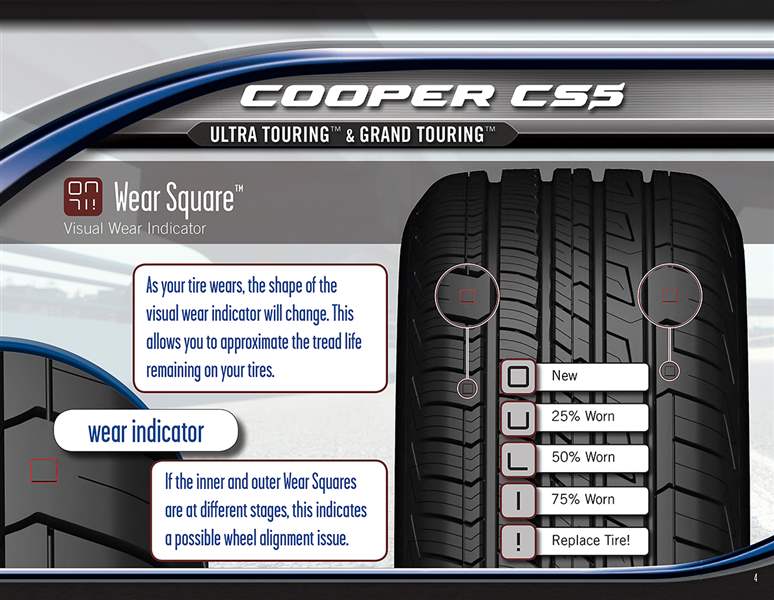
Cooper rolls out device to evalute wear on tires
Penny saved might be dollars earned for plant
6/6/2014
Cooper Tires’ new Wear Square tread alert system is available only on the CS5 Touring line.

Cooper Tires’ new Wear Square tread alert system is available only on the CS5 Touring line.
FINDLAY — A new development from Cooper Tire & Rubber Co. may make ol’ Abe Lincoln’s head obsolete.
For years, the penny test has been a quick way to determine when it’s time to get new tires. The space between the top of the coin and the raised profile of President Lincoln just happens to be 1/16 of an inch — the minimum depth considered safe for tire tread. If you stick the coin in the treads and find any of Lincoln’s head is covered, you’re good to go. If it’s not, you need new tires.
Not exactly scientific, but it works.
Cooper thinks it has found a better way to tell drivers when they need new tires — no change required.
A little more than a month ago, the Findlay company rolled out a new visual wear indicator it calls the Wear Square. Company officials say the development should make it easier than ever for drivers to determine when they need new rubber.
Six small indicator boxes are molded into the tread pattern of the tire. As rubber wears away, the symbol transitions through five stages. When the tread reaches 1/16 of an inch, the box shows an exclamation mark.
“We like to say it’s convenience and confidence in one little box,” said Scott Jamieson, Cooper’s director of product management in North America.
That’s a cute tagline that figures to feature in Cooper’s promotion of the indicator, which is available only on the CS5 Touring line. But it speaks exactly to how Cooper views the innovation as it tries to find new and creative ways to connect with consumers.
In the case of the CS5 Touring, Cooper unveiled several developments, including a new tread pattern that keeps grooves from narrowing over the life of the tire, and a second-generation silica tread compound with an advanced polymer formulation.
While that may get tire engineers revved up, most consumers don’t know a thing about silica or advanced polymers. And they probably don’t care to.
But Cooper found the idea of an easy way to tell when tires are worn out does resonate with consumers.
The company conducted a five-city survey in which they asked people who were in the market for tires or had recently purchased tires what they thought of the CS5’s features.
“We found the Wear Square overwhelmingly was something that would make people purchase the CS5 over a competitor because of that feature and the benefit they got from it,” Mr. Jamieson said. “It led to trust. It led to confidence.”
The boxes are situated in three spots around the tire on both the inside and outside edge. Cooper says that not only allows consumers to see how much tread life they have left, but it will show when tires are wearing unevenly.
All tires sold in the United States, including Cooper’s new CS5, are required by the U.S. Department of Transportation to have wear bars that run horizontally across the tread pattern. When the wear bar is exposed, it’s time to replace the tire.
Cooper officials, though, say no one else has done what they have.
“It’s a pretty unique innovation they have, and we’ll see at the end of the day if it leads to any more tire sales over the long run. You’ve gotta give them credit for being creative,” said Nick Mitchell, a tire industry analyst at Northcoast Research in Cleveland.
For most, buying tires is only slightly more exciting than receiving socks for Christmas. And tires all look more or less the same.
That’s why Mr. Jamieson said it’s so important to find a way to differentiate your product, especially one that makes sense to consumers.
Though tires may seem all the same, there’s actually a lot of thought and testing that goes into launching a new tire. Cooper used 5,000 tires of differing compounds and tread patterns before settling on the one that ultimately became the CS5
Mr. Jamieson also said the tires went through 1.2 million miles of testing on the company’s Texas test track and others.
Mr. Mitchell said the Wear Square is almost as interesting for what it’s not as what it is.
“Usually the emphasis is on improving the performance of the tire,” he said. “Reducing rolling resistance, improving traction on wet pavement, quieting the noise, improving ride quality. But there Cooper took a little bit of a spin, instead of just making a strong performing tire, they added something that’s unique and not related to performance, but an attribute that appeals to the other needs of the customer.”
Contact Tyrel Linkhorn at tlinkhorn@theblade.com or 419-724-6134 or on Twitter @BladeAutoWriter.